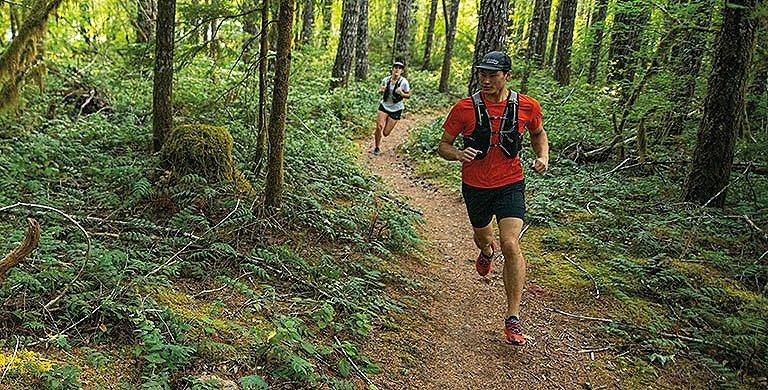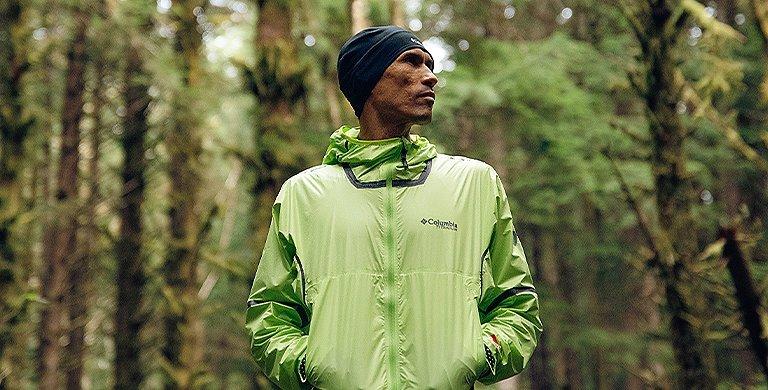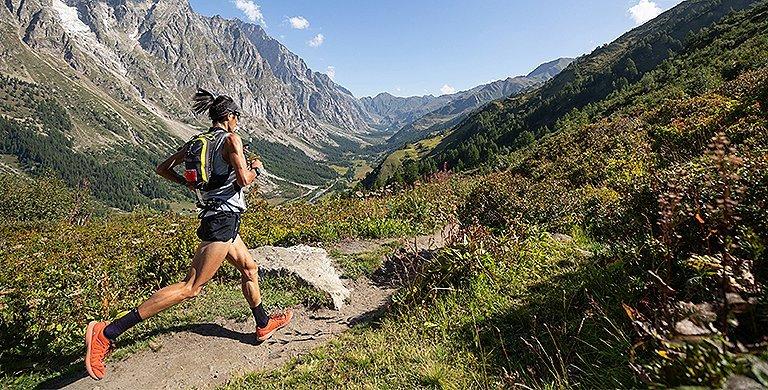TRAIL RUNNING
How to Stay Cool While Running
From sun-protective clothing to hydration tips, here’s how to beat the heat on your next trail run
BY MICHELE ELDER
Few things inspire people to get outdoors quite like warm summer days, and trail running enthusiasts are no exception. When running in the summer, however, warm can quickly start feeling hot and sticky, which can ruin that amazing runner’s high you came for.
To help you feel better equipped for the heat of the trail and get the most out of your summer runs, we’ve answered some questions about how the body reacts to heat and offered practical tips for how to stay cool while running.
You can also check out our guide to training for trial running to make you’re your body is ready to hit the trails.
To help you feel better equipped for the heat of the trail and get the most out of your summer runs, we’ve answered some questions about how the body reacts to heat and offered practical tips for how to stay cool while running.
You can also check out our guide to training for trial running to make you’re your body is ready to hit the trails.
Why do I struggle running in the heat?
The human body is made with an efficient cooling system that works brilliantly in moderate temperatures, but when the heat rises, that built-in system can sometimes struggle to keep up.
The body has two means of cooling itself: sweat, which cools the skin as it evaporates; and vasodilation, where blood flow transfers heat generated from hardworking muscles to the body’s cooler skin. When external heat requires your body to significantly ramp up its cooling system, the blood flow will default to the skin to release internal heat, which means less oxygen gets to your muscles, making you and your muscles work harder.
The body has two means of cooling itself: sweat, which cools the skin as it evaporates; and vasodilation, where blood flow transfers heat generated from hardworking muscles to the body’s cooler skin. When external heat requires your body to significantly ramp up its cooling system, the blood flow will default to the skin to release internal heat, which means less oxygen gets to your muscles, making you and your muscles work harder.
How to prevent overheating while running
1. Dial in your hydration
Staying properly hydrated on the running trail isn’t just about quenching your thirst. Be sure you have a hydration plan that includes the proper amount of water necessary for the duration of your run, and set reminders to help you remember to hydrate even when you’re in the groove. Stay well hydrated the day before and after a hot run, and if you know you’ll be hitting the trail in extreme heat, consider including sports drinks in your hydration plan to recoup electrolytes.
2. Pick shady trails
As enticing as wide-open spaces can be for a good trail run, they can be daunting in blazing 100° heat. Instead, look for forest trails that not only provide plenty of shade trees, but also offer the sounds of nature. And if you can find a trail next to a burbling stream, all the better.
3. Wear clothes with cooling tech
Whether it’s a long-sleeve shirt to keep you cool in the heat or a hat designed to protect your scalp from the sun, investing in trail clothes with built-in cooling technologies such as Omni-Freeze ZERO™ or Omni-Freeze ZERO Ice™ is another great way to beat the heat. These technologies offer touch- and sweat-activated cooling features that release heat while still feeling cooler to the touch. And a special sweat-wicking process provides extra comfort by keeping you dry.
Staying properly hydrated on the running trail isn’t just about quenching your thirst. Be sure you have a hydration plan that includes the proper amount of water necessary for the duration of your run, and set reminders to help you remember to hydrate even when you’re in the groove. Stay well hydrated the day before and after a hot run, and if you know you’ll be hitting the trail in extreme heat, consider including sports drinks in your hydration plan to recoup electrolytes.
2. Pick shady trails
As enticing as wide-open spaces can be for a good trail run, they can be daunting in blazing 100° heat. Instead, look for forest trails that not only provide plenty of shade trees, but also offer the sounds of nature. And if you can find a trail next to a burbling stream, all the better.
3. Wear clothes with cooling tech
Whether it’s a long-sleeve shirt to keep you cool in the heat or a hat designed to protect your scalp from the sun, investing in trail clothes with built-in cooling technologies such as Omni-Freeze ZERO™ or Omni-Freeze ZERO Ice™ is another great way to beat the heat. These technologies offer touch- and sweat-activated cooling features that release heat while still feeling cooler to the touch. And a special sweat-wicking process provides extra comfort by keeping you dry.
4. Be smart with your timing
Avoid the heat of the day by considering the timing of your run. Dawn or early morning runs can provide a delightfully cool trail running experience, while dusk or evening runs benefit from dropping temps. Trail running at either end of the day can be especially peaceful, and if your timing includes dark skies, you can even find cooling gear with reflective features to help you stay visible.
5. Use evaporative cooling
Evaporative cooling isn’t just for the pool. You can stay cool during your run by pouring water on yourself, taking a quick detour into a stream or lake, or even by getting your clothes wet before you start your run. And wearing trail running gear made with synthetic, quick-drying fabric will help keep you comfortable while you’re cooling off.
6. Take care of your feet
It’s hard to feel cool and comfortable when your feet are hot and soggy. Believe us when we say that investing in good moisture-wicking socks and high-quality trail running shoes that feature breathable mesh materials will not only help keep you cool enough to focus on enjoying your run, but will also reduce the chance of blisters, foot fungus, and other unpleasant trail running conditions.
Avoid the heat of the day by considering the timing of your run. Dawn or early morning runs can provide a delightfully cool trail running experience, while dusk or evening runs benefit from dropping temps. Trail running at either end of the day can be especially peaceful, and if your timing includes dark skies, you can even find cooling gear with reflective features to help you stay visible.
5. Use evaporative cooling
Evaporative cooling isn’t just for the pool. You can stay cool during your run by pouring water on yourself, taking a quick detour into a stream or lake, or even by getting your clothes wet before you start your run. And wearing trail running gear made with synthetic, quick-drying fabric will help keep you comfortable while you’re cooling off.
6. Take care of your feet
It’s hard to feel cool and comfortable when your feet are hot and soggy. Believe us when we say that investing in good moisture-wicking socks and high-quality trail running shoes that feature breathable mesh materials will not only help keep you cool enough to focus on enjoying your run, but will also reduce the chance of blisters, foot fungus, and other unpleasant trail running conditions.
7. Opt for sun-protective clothing
Don’t forget about sun protection when your trail run takes you out in the open. Sun-protective clothing made with UV-rated fabric technologies like Omni-Shade™ not only protects your skin from UV rays, it also helps keep you cool. In fact, a recent study found that UPF fabric works better than sunscreen, so if your trail run plans include the blazing sun, consider using a long-sleeve sun protection shirt in addition to sunscreen.
8. Run by the water
If your favorite running trails take you out into the wide open, consider a change of scenery on especially hot days by choosing a trail near water instead. Temperatures along forest streams, lakes, or even city rivers are generally a little cooler and can offer a more comfortable running experience. Remember that bodies of water also usually mean higher humidity, which can make you feel even hotter and often zap your energy faster than dry heat, so it’s a good idea to check the weather stats if you’ll be running close to water.
9. Precool your body
Lowering the body’s core temperature with precooling techniques has been found to be beneficial for exertion in hot conditions by extending the time it takes for the body to reach its temperature threshold. So if you’re planning on hitting the running trail on an especially hot day, before you head out consider spending a few minutes with an icy towel wrapped around your neck, wearing an ice vest, or sitting in a well air-conditioned room. Even treating yourself to a tasty slushy before your run can bring your core temperature down enough to help keep you out on the trail longer.
10. Invest in a UPF-rated cooling hat
Wearing a UPF-rated hat with Omni-Freeze ZERO™ or Omni-Freeze ZERO Ice™ will help keep your head cool as the sun bears down via sweat-activated technology. Not only that, it will also provide sun protection for your face and scalp. To get even more cooling power out of your hat, get it wet—soak it before you head out or dunk it in a lake or river as you run by. For longer-lasting cooling, fill a sandwich bag with ice and tuck it under your hat to stay cool as the ice melts.
Don’t forget about sun protection when your trail run takes you out in the open. Sun-protective clothing made with UV-rated fabric technologies like Omni-Shade™ not only protects your skin from UV rays, it also helps keep you cool. In fact, a recent study found that UPF fabric works better than sunscreen, so if your trail run plans include the blazing sun, consider using a long-sleeve sun protection shirt in addition to sunscreen.
8. Run by the water
If your favorite running trails take you out into the wide open, consider a change of scenery on especially hot days by choosing a trail near water instead. Temperatures along forest streams, lakes, or even city rivers are generally a little cooler and can offer a more comfortable running experience. Remember that bodies of water also usually mean higher humidity, which can make you feel even hotter and often zap your energy faster than dry heat, so it’s a good idea to check the weather stats if you’ll be running close to water.
9. Precool your body
Lowering the body’s core temperature with precooling techniques has been found to be beneficial for exertion in hot conditions by extending the time it takes for the body to reach its temperature threshold. So if you’re planning on hitting the running trail on an especially hot day, before you head out consider spending a few minutes with an icy towel wrapped around your neck, wearing an ice vest, or sitting in a well air-conditioned room. Even treating yourself to a tasty slushy before your run can bring your core temperature down enough to help keep you out on the trail longer.
10. Invest in a UPF-rated cooling hat
Wearing a UPF-rated hat with Omni-Freeze ZERO™ or Omni-Freeze ZERO Ice™ will help keep your head cool as the sun bears down via sweat-activated technology. Not only that, it will also provide sun protection for your face and scalp. To get even more cooling power out of your hat, get it wet—soak it before you head out or dunk it in a lake or river as you run by. For longer-lasting cooling, fill a sandwich bag with ice and tuck it under your hat to stay cool as the ice melts.
Need hot weather running gear? Check out Columbia Sportswear’s selection.



